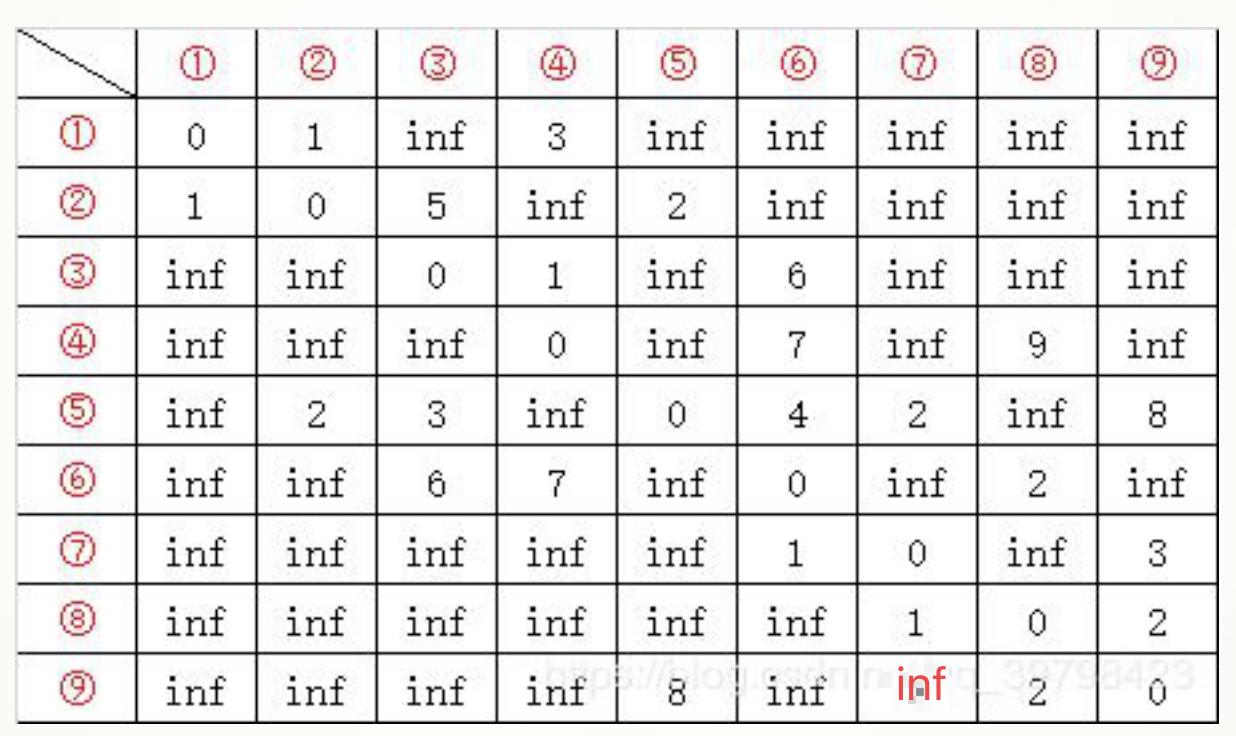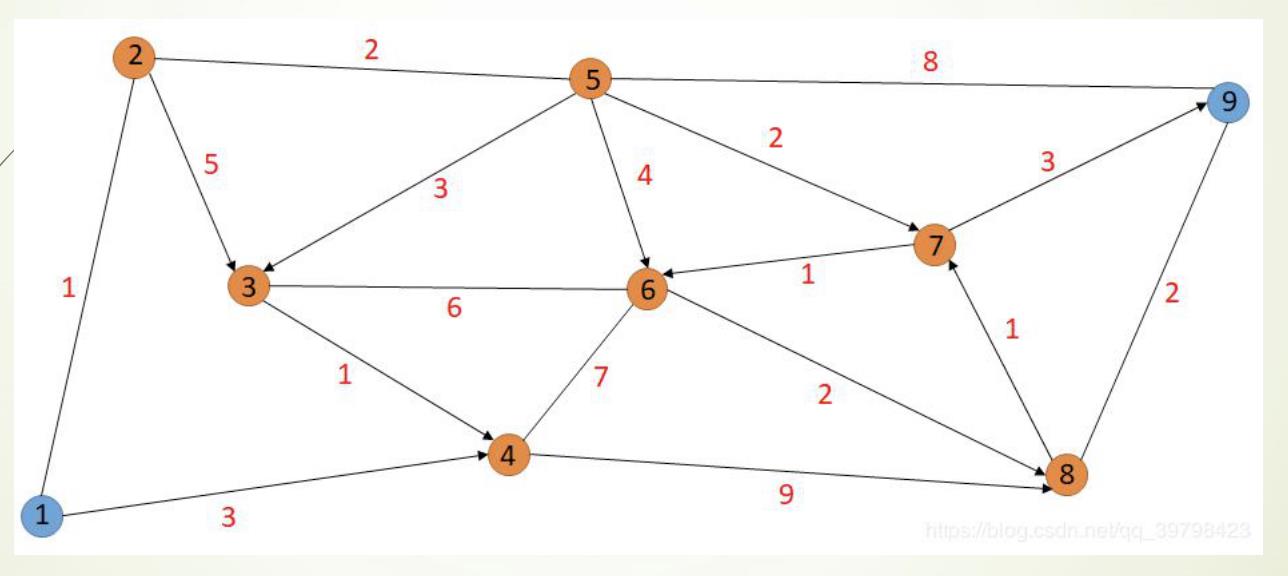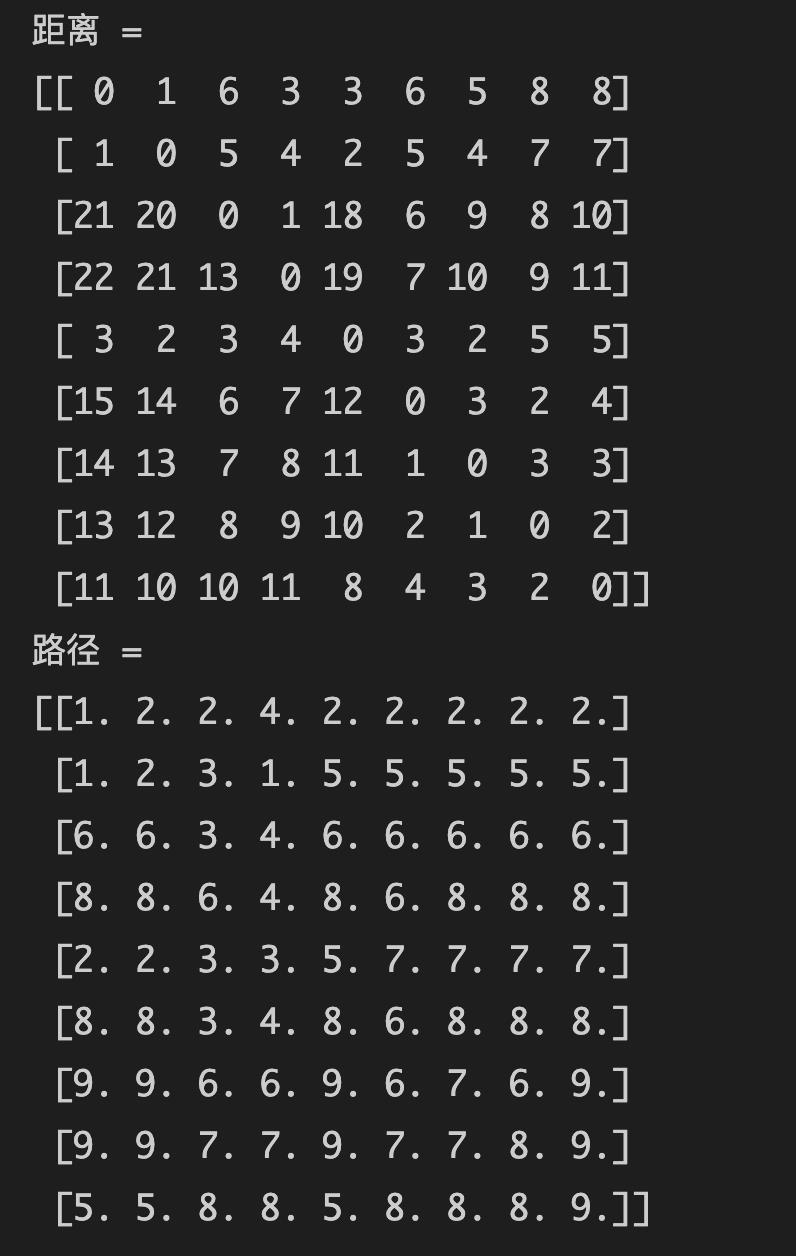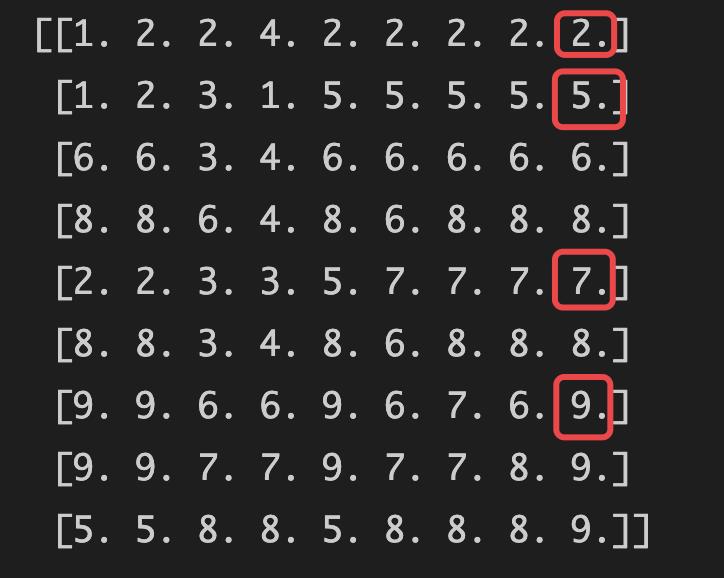Python数学建模系列:图论
Posted 海轰Pro
tags:
篇首语:本文由小常识网(cha138.com)小编为大家整理,主要介绍了Python数学建模系列:图论相关的知识,希望对你有一定的参考价值。
文章目录
前言
Hello!小伙伴!
非常感谢您阅读海轰的文章,倘若文中有错误的地方,欢迎您指出~
自我介绍 ଘ(੭ˊᵕˋ)੭
昵称:海轰
标签:程序猿|C++选手|学生
简介:因C语言结识编程,随后转入计算机专业,有幸拿过一些国奖、省奖…已保研。目前正在学习C++/Linux/Python
学习经验:扎实基础 + 多做笔记 + 多敲代码 + 多思考 + 学好英语!
初学Python 小白阶段
文章仅作为自己的学习笔记 用于知识体系建立以及复习
题不在多 学一题 懂一题
知其然 知其所以然!
往期文章
1 图论模型 - Dijkstra
Dijkstra算法能求一个顶点到另一顶点最短路径。
基础概念
- 无向图: 若图中的每条边都是没有方向的,则称该图为无向图。
- 有向图: 若图中的每条边都是有方向的,则称该图为有向图。
- 混合图: 若图中的部分边是有方向的,而部分边是无方向的,则称该图为混合图。
样例1
如下图所示,我们需要从①点走到⑨点,每条边的红色数 字代表这条边的长度,我们如何找到①到⑨的最短路径呢?

步骤:
- 将①标记为P,其它标记为T,找出从①出发当前最短的边所到的点,将该点的T改为P
- 将所有P点找到可以到达的T标记点上最短的边,将到达的点T改为P
- 重复步骤,指导终点的T变为P
过程展示:圈加数字代表每个顶点,()内数字代表当前行走的距离
1.①(0)
2.①②(1)
3.①②⑤(3)
4.①②⑤(3) ①④(3)
5.①②⑤⑦(5) ①④(3)
6.①②⑤⑦⑥(6) ①④(3)
7.①②⑤⑦⑥(6) ①②⑤③(6) ①④(3)
8.①②⑤⑦⑥(6) ①②⑤③④(7) ①④(3)
9.①②⑤⑦⑥⑧(8) ①②⑤③④(7) ①④(3)
10.①②⑤⑦⑥⑧(8) ①②⑤⑦⑨(8) ①②⑤③④(7) ①④(3)
所以最短的路径是 ① ② ⑤ ⑦ ⑨, 长度为8
带权邻接矩阵: 带权邻接矩阵是表示顶点相邻关系的矩阵,例如上面那个图的带权邻接矩阵如下

注意:原PPT中有错误,
点9 -> 点7 应该为inf(上图已经修改)
每个点和自己的距离为0(主对角线上元素都是零)
在图上相邻两个点的如果是连通的,距离就是矩阵的值,无向 的关于主对角线对称;有向的只有可以过去的路有数值
无法连通的距离就是无穷,记为inf
Demo代码
# 运行环境:Vs Code
# PPT中代码有点错误 已经修改~
# 以下代码经测试 可行
from collections import defaultdict
from heapq import *
inf = 99999 # 不连通值
mtx_graph = [[0, 1, inf, 3, inf, inf, inf, inf, inf],
[1, 0, 5, inf, 2, inf, inf, inf, inf],
[inf, inf, 0, 1, inf, 6, inf, inf, inf],
[inf, inf, inf, 0, inf, 7, inf, 9, inf],
[inf, 2, 3, inf, 0, 4, 2, inf, 8],
[inf, inf, 6, 7, inf, 0, inf, 2, inf],
[inf, inf, inf, inf, inf, 1, 0, inf, 3],
[inf, inf, inf, inf, inf, inf, 1, 0, 2],
[inf, inf, inf, inf, 8, inf, inf, 2, 0]]
m_n = len(mtx_graph)#带权连接矩阵的阶数
edges = [] #保存连通的两个点之间的距离(点A、点B、距离)
for i in range(m_n):
for j in range(m_n):
if i!=j and mtx_graph[i][j]!=inf:
edges.append((i,j,mtx_graph[i][j]))
def dijkstra(edges, from_node, to_node):
go_path = []
to_node = to_node-1
g = defaultdict(list)
for l,r,c in edges:
# l:点A r:点B c:距离
# 字典: 点A -> (距离,点B)
g[l].append((c,r))
q, seen = [(0, from_node-1, ())], set()
while q:
(cost, v1, path) = heappop(q)#堆弹出当前路径最小成本
if v1 not in seen:
seen.add(v1)
path = (v1, path)
if v1 == to_node:
break
for c, v2 in g.get(v1, ()):
if v2 not in seen:
heappush(q, (cost+c, v2, path))
if v1!=to_node: #无法到达
return float('inf'), []
if len(path)>0:
left=path[0]
go_path.append(left)
right=path[1]
while len(right)>0:
left=right[0]
go_path.append(left)
right=right[1]
go_path.reverse() #逆序变换
for i in range(len(go_path)): #标号加1
go_path[i]=go_path[i]+1
return cost, go_path
leght, path = dijkstra(edges, 1, 9)
print('最短距离为:'+str(leght))
print('前进路径为:'+str(path))
运行结果
最短距离为:8
前进路径为:[1, 2, 5, 7, 9]

2 图论模型-Floyd
Floyd算法通过动态规划解决任意两点间的最短路径(多源最短路径)的问题,可以正确处理负权的最短路径问题
关键原理:
d [ i ] [ j ] = m i n ( d [ i ] [ k ] + d [ k ] [ j ] ) ( 1 < = k < = n ) d[i][j] = min(d[i][k] + d[k][j]) (1 <= k <= n) d[i][j]=min(d[i][k]+d[k][j])(1<=k<=n)
枚举中间点k,找到最小的 d [ i ] [ k ] + d [ k ] [ j ] d[i][k] + d[k][j] d[i][k]+d[k][j],作为 d [ i ] [ j ] d[i][j] d[i][j]的最小值
关键结论:
假设i和j之间的最短路径上的结点集里(不包含i,j),编号最大的一个是x.那么在外循环k = x时, d [ i ] [ j ] d[i][j] d[i][j] 肯定得到了最小值.
强归纳法 :
设i到x中间编号最大的是x1,x到j中间编号最大的是x2.由于x是i到j中间编号最大的,那么显然 x 1 < x , x 2 < x x_1 < x , x_2 < x x1<x,x2<x
根据结论,
k
=
x
1
k= x_1
k=x1时候
d
[
i
]
[
x
]
d [i][x]
d[i][x]已经取得最小值,
k
=
x
2
k = x_2
k=x2时候
d
[
x
]
[
j
]
d [x][j]
d[x][j]已经取得最
小值
那么 k = x k=x k=x时, d [ i ] [ x ] d[i][x] d[i][x]和 d [ x ] [ j ] d [x][j] d[x][j]已经都取得最小值.
因此 k = x k= x k=x时,执行 d [ i ] [ j ] = m i n ( d [ i ] [ j ] , d [ i ] [ k ] + d [ k ] [ j ] ) 得 d [ i ] [ j ] d[i][j]=min(d[i][j],d[i][k]+d[k][j]) 得d[i][j] d[i][j]=min(d[i][j],d[i][k]+d[k][j])得d[i][j]
样例2
与样例1相似,只是这次我们求出从每一个点到其他点的最短距离和路径,每条边的红色数字代表这条边的长度。

Demo代码
from collections import defaultdict
from heapq import *
import numpy as np
inf = 99999 # 不连通值
mtx_graph = [[0, 1, inf, 3, inf, inf, inf, inf, inf],
[1, 0, 5, inf, 2, inf, inf, inf, inf],
[inf, inf, 0, 1, inf, 6, inf, inf, inf],
[inf, inf, inf, 0, inf, 7, inf, 9, inf],
[inf, 2, 3, inf, 0, 4, 2, inf, 8],
[inf, inf, 6, 7, inf, 0, inf, 2, inf],
[inf, inf, inf, inf, inf, 1, 0, inf, 3],
[inf, inf, inf, inf, inf, inf, 1, 0, 2],
[inf, inf, inf, inf, 8, inf, inf, 2, 0]]
def Floyd(graph):
N=len(graph)
A=np.array(graph)
path=np.zeros((N,N))
for i in range(0,N):
for j in range(0,N):
if A[i][j]!=inf:
path[i][j]=j
for k in range(0,N):
for i in range(0,N):
for j in range(0,N):
# 原PPT这一句代码有错 写成了 A[i][j]+A[k][j]<A[i][j]
# 正确应该是:A[i][k]+A[k][j]<A[i][j]
if A[i][k]+A[k][j]<A[i][j]:
A[i][j]=A[i][k]+A[k][j]
path[i][j]=path[i][k]
for i in range(0,N):
for j in range(0,N):
path[i][j]=path[i][j]+1
print('距离 = ')
print(A)
print('路径 = ')
print(path)
Floyd(mtx_graph)
运行结果

注意:原PPT 结果中 最后一行又错 应该是
5. 5. 8. 8. 5. 8. 8. 8. 9.PPT中是:5. 5. 7. 7. 5. 7. 7. 8. 9.因为在最初的mtx_graph设置就错了:点9到点7 应该是inf 而不是 3
结论:
- 从点1 到 点9 的距离为8(结果中“距离”矩阵中第一行第九列数值)
- 路径为【1 - 2 - 5 - 7 - 9】
怎么看路径呢?
- 从最后结果中查看”路径“矩阵
- 点1 到 点9 首先看第一行第九列 数值为2
- 这是中间位置2,再看第二行第九列,数值为5
- 再看第五行第九列,数值为7
- 再看第七行第九列,数值为9
- 得到最终路径【1 - 2 - 5 - 7 - 9】

3 机场航线设计
数据集来自航空业,有一些关于航线的基本信息。有某段旅程的起始点和目的地。还有一些列表示每段旅程的到达和起飞时间。这个数据集非常适合作为图进行分析。想象一下通过航线(边)连接的几个城市(节点)。
如果你是航空公司,你可以问如下几个问题:
- 从A到B的最短途径是什么?分别从距离和时间角度考虑。
- 有没有办法从C到D?
- 哪些机场的交通最繁忙?
- 哪个机场位于大多数其他机场“之间”?这样它就可以变成当地的一个中转站。
0、Airlines.csv数据

1、数据导入、观察变量
import numpy as np
import pandas as pd
data = pd.read_csv('../Profile/Airlines.csv')
data.shape #数据大小
# (100, 16) 100行16列
运行结果

查看各个变量的类型
data.dtypes # 各变量的类型
运行结果

2、数据清洗
#将sched_dep_time转换为'std'—预定的出发时间
data['std'] = data.sched_dep_time.astype(str).str.replace('(\\d{2}$)', '') + ':' + data.sched_dep_time.astype(str).str.extract('(\\d{2}$)', expand=False) + ':00'
#将sched_arr_time转换为“sta”—预定到达时间
data['sta'] = data.sched_arr_time.astype(str).str.replace('(\\d{2}$)', '') + ':' + data.sched_arr_time.astype(str).str.extract('(\\d{2}$)', expand=False) + ':00'
#将dep_time转换为'atd' -实际出发时间
data['atd'] = data.dep_time.fillna(0).astype(np.以上是关于Python数学建模系列:图论的主要内容,如果未能解决你的问题,请参考以下文章
机器学习|数学基础Mathematics for Machine Learning系列之图论:匹配的概念
机器学习|数学基础Mathematics for Machine Learning系列之图论:匹配的概念
机器学习|数学基础Mathematics for Machine Learning系列之图论:树及其性质
机器学习|数学基础Mathematics for Machine Learning系列之图论:树及其性质